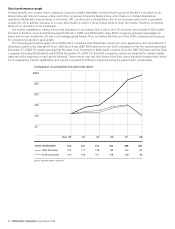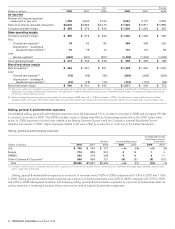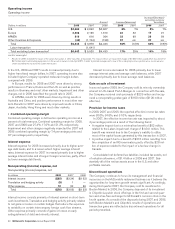McDonalds 2008 Annual Report Download - page 24
Download and view the complete annual report
Please find page 24 of the 2008 McDonalds annual report below. You can navigate through the pages in the report by either clicking on the pages listed below, or by using the keyword search tool below to find specific information within the annual report.records franchised revenues and are indicative of the financial
health of our franchisee base.
• Return on incremental invested capital (ROIIC) is a measure
reviewed by management over one-year and three-year time
periods to evaluate the overall profitability of the business units,
the effectiveness of capital deployed and the future allocation of
capital. The return is calculated by dividing the change in operat-
ing income plus depreciation and amortization (numerator) by
the adjusted cash used for investing activities (denominator),
primarily capital expenditures. The calculation assumes a con-
stant average foreign exchange rate over the periods included in
the calculation.
Strategic direction and financial performance
The strength of the alignment between the Company, its franchi-
sees and suppliers (collectively referred to as the System) has
been key to McDonald’s success over the years. This business
model enables McDonald’s to consistently deliver locally-relevant
restaurant experiences to customers and be an integral part of the
communities we serve. In addition, it facilitates our ability to identi-
fy, implement and scale innovative ideas that meet our customers’
changing needs and preferences.
McDonald’s customer-centered Plan to Win — which is
focused on being better, not just bigger — provides a common
framework for our restaurants yet allows for local adaptation. The
Plan facilitates the execution of multiple initiatives surrounding the
five factors of exceptional customer experiences — people, prod-
ucts, place, price and promotion. Through the execution of these
initiatives, we have enhanced the McDonald’s experience for cus-
tomers worldwide, growing sales and guest counts in each of the
last five years. This Plan, coupled with financial discipline, has
delivered strong results for shareholders.
We have exceeded our long-term, constant currency financial
targets of average annual Systemwide sales and revenue growth
of 3% to 5%; average annual operating income growth of 6% to
7%; and annual returns on incremental invested capital in the high
teens every year since the Plan’s implementation in 2003, after
adjusting 2007 for the Latin America developmental license
transaction. Given the size and scope of our global business, we
believe these financial targets are realistic and sustainable,
enabling us to focus on those opportunities that best optimize
long-term shareholder value.
In 2008, we continued to focus on our key global success
factors of branded affordability, menu variety and beverage choice,
convenience and daypart expansion, ongoing restaurant reinvest-
ment and operations excellence. Locally-relevant initiatives around
each of these success factors resonated with consumers’ increas-
ingly busy lifestyles and their growing demand for menu variety,
value and simple, enjoyable eating-out experiences. As a result,
every area of the world contributed to 2008 global comparable
sales and guest counts increasing 6.9% and 3.1%, respectively,
despite a challenging economic environment in many countries.
In the U.S., we continued to drive sales higher and increase our
share of the informal eating-out market in 2008 due to our
ongoing focus on breakfast, chicken, beverages, convenience and
branded affordability. We extended our leadership in the breakfast
and chicken categories with the launch of the Southern Style
Chicken Biscuit for breakfast and Southern Style Chicken Sand-
wich for the remainder of the day. We profitably built greater visit
frequency by leveraging our convenient locations, extended hours,
drive-thru service and value-oriented local beverage promotions
that often featured our popular Iced Coffee and Sweet Tea. As part
of our multi-year strategy to take advantage of the significant and
growing beverage category, we began rolling-out espresso-based
hot and cold specialty coffees. At year-end 2008, over 7,000 res-
taurants were offering the new specialty coffees, and we expect to
complete the roll-out in mid-2009. To accommodate the related
new equipment as well as enable potential future offerings such as
smoothies, frappes and bottled beverages, construction is required
in many restaurants. In most cases this construction also involves
expanding and optimizing the efficiency of our drive-thru booth,
which enables us to better serve even more customers, faster. The
Company is investing capital to fund a portion of this construction-
related reinvestment for franchised restaurants.
In Europe, we posted record-high comparable sales growth in
2008. Every country contributed to this performance, which was
led by France, the U.K., Russia and Germany. This success was
driven in part by greater local customer relevance created by our
tiered menu approach, featuring an effective combination of pre-
mium selections, classic menu favorites, everyday value and
popular limited-time food promotions. We also connected with
customers throughout the day with new sandwiches such as the
Bacon Roll for breakfast in the U.K. and premium M burger in
France, Germany and the U.K. We continued upgrading the
McDonald’s experience by reimaging more than 650 locations,
primarily in the U.K. and Germany. In addition, we continued the
roll-out of a new kitchen operating system — currently in about
5,000 of our European restaurants — to enhance operational effi-
ciency and support greater menu variety. Open communication and
transparency is especially important to European consumers. To
build brand trust, we actively communicated the facts about
McDonald’s as an employer and highlighted the quality and
nutrition of our food with the early launch of the Company’s new
global packaging design.
In APMEA, our momentum continued with nearly every country
delivering positive comparable sales, driven by Australia, Japan and
China. In addition, aggressive restaurant development in China —
where we opened our 1,000th restaurant — contributed to rev-
enue growth. Our performance was driven by strategic initiatives
surrounding convenience, breakfast, core menu extensions and
value. We further enhanced McDonald’s convenience with drive-
thru and delivery service, as well as expansion of extended hours
to 60% (or about 5,000) of our restaurants in APMEA. We built on
the momentum of our breakfast business, currently in 70% of our
restaurants in APMEA, by raising customer awareness, trial and
visit frequency with relevant marketing and new menu offerings
like the egg, tomato and pepper McPuff in China. We also con-
tinued to appeal to customers with branded affordability platforms
and locally-relevant new product launches such as the premium
chicken line in Australia and New Zealand.
Our customer-centered strategies to drive global momentum
also consider price and product mix as a means to enhance
restaurant profitability. This approach is complemented by a focus
on optimizing restaurant operations and effectively managing food
and paper costs by leveraging our scale, supply chain infra-
structure and risk management strategies. As a result, amid a
volatile commodity environment, McDonald’s delivered con-
solidated Company-operated restaurant margins of 17.6% – its
highest in nine years.
Strong sales and margin performance positively impacted
growth in cash from operations, which rose $1 billion to
$5.9 billion in 2008. Our substantial cash flow, strong credit rating
and continued access to credit provides us significant flexibility to
22 McDonald’s Corporation Annual Report 2008
























